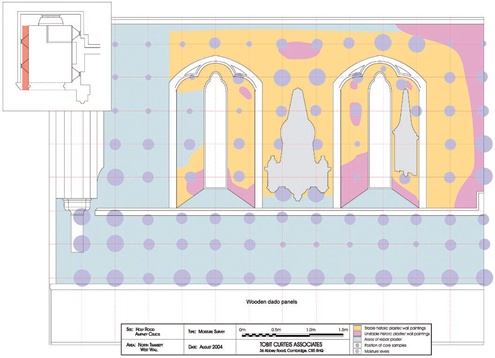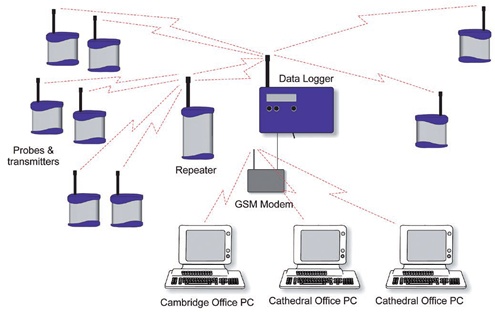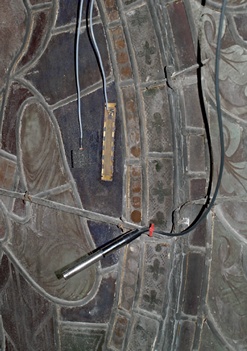The Survey and Identification of
Environmental Deterioration
Tobit Curteis
 |
|
| Figure 1: The Chinese Palace, Oranienbaum, Russia; localised deterioration patterns characteristic of low level liquid water sources |
Adverse environmental conditions are among the most significant influences on the deterioration of historic buildings. Broadly speaking, the causes of such damage can be separated into those factors associated with the failure of the building envelope and those caused by the internal microclimate, although in practice the two areas are generally interdependent. While there are many environmental factors which can cause damage, the most significant, and the one that will be discussed in most detail in this article, is damp. If water-related deterioration is to be controlled, it is essential that the precise cause and mechanism of the damage is understood so that control measures can be designed accurately.
Damaged buildings and artefacts display a range of symptoms which may be characteristic of the type of deterioration. However, the symptoms are not necessarily specific to a particular deterioration source. It is therefore often easier, and in the short term cheaper, to treat the symptoms rather than to identify and control their source. The widespread use of cementicious render and bituminous paint to control rising damp in churches in the 19th and early 20th centuries is an all too common example of this approach. As the source of the deterioration was often left untreated, it should have come as no surprise that the damage simply returned.
A HISTORY OF MISUNDERSTANDINGS
The history of building conservation is littered with examples of inappropriate treatments being applied to misunderstood problems. In many cases these treatments have caused further damage to the buildings they were intended to help. In some cases this is caused by a simple misreading of the symptoms, while in others it is the result of inappropriate interventions.
A classic example of the former is the misidentification of rainwater penetration on an external wall, when in fact damage is being caused by condensation resulting from the localised cooling of the wall by the evaporation of rainwater from the external surface. This can lead to expensive pointing or structural repairs being undertaken when a modification of the internal microclimatic conditions or the application of thermal insulation to the wall may be more appropriate.
In other cases, the cause of deterioration may be understood but the ways in which the remedial measures will work are not fully appreciated. This is sometimes the case with the gravel-filled trenches often known as French drains. Designed for draining waterlogged soil, these were invented in the mid-19th century by Henry French, an American agricultural engineer. In the context of building remediation, French drains can also be useful as a means of reducing the horizontal transport of moisture from the surrounding ground. However, in many cases this type of drainage is installed in an attempt to aid evaporation from a wall suffering from rising damp. In this case, the system has only a limited effect as the moisture content of the air between the stones quickly reaches saturation, preventing any evaporation into the gravel.
In these examples, as in many others, a careful assessment of both the damage and the proposed remedial measures can be a useful and cost-effective step in accurately identifying the underlying causes of deterioration and designing effective controls.
 |
|
| Figure 2: Mapping electrical capacitance readings and patterns of deterioration on the 13th century wall paintings at Holy Rood Church, Ampney Crucis, Gloucestershire |
BASIC ASSESSMENT
The first step in assessing any suspected moisture damage in historic buildings is to examine the nature and distribution of the damage. Different moisture sources generally result in different patterns and types of damage. Broadly speaking, damage associated with liquid water is localised and severe, while that caused by microclimatic factors is more widespread and evenly distributed.
Most of the basic investigation can be achieved with a careful study of the building envelope and the moisture transport routes. The design of any successful building envelope should enable rainwater deposited on the outer shell to be transported away to a safe location. If there is water damage on the internal surfaces, it suggests that either the design itself is faulty or that the system is damaged (Figure 1).
A similar approach can be taken to the basic assessment of the internal microclimate. If the building envelope is functioning successfully, then, in the absence of artificial influences such as heating and ventilation, it should achieve a predictable level of buffering between the internal and external conditions. If there is instability in the microclimate, then it is probable either that the envelope is not functioning correctly or that artificial influences are destabilising the situation.
MONITORING AND MEASUREMENT
In many cases the simple identification of the probable sources of deterioration may be enough to allow suitable control measures to be designed. In some cases, however, the precise nature of the deterioration needs to be more accurately defined and in these instances fuller technical investigations may be necessary.
One of the simplest forms of moisture investigation involves the use of hand-held electrical resistance or capacitance meters. These instruments, which are generally designed for measuring the moisture content of timber, are sometimes dismissed as being of limited use in building investigation as they can be influenced by the presence of electrolytes such as hygroscopic salts.(1) However, they are non-invasive, quick to use and provided they are used by a practitioner skilled enough to interpret the data, they are an invaluable basic measurement tool.
Simple resistance and capacitance data plotted onto plans and elevations can provide a very useful overview of the correlation between current moisture distribution and elements of the building structure or rainwater disposal system. Such data can also give a clear indication of whether damage is being caused by an active moisture source or is simply the residual symptom of a historic problem (Figure 2).
If it is necessary to examine the moisture conditions within the structure of the wall (for instance, to differentiate between horizontal transfer of rainwater and localised condensation, as discussed above) then various core sampling techniques can be employed. These range from micro cores, often used to examine the very precise stratigraphic distribution of salts near the wall surface, to deep cores used to establish the pattern of moisture throughout the wall.
Salt analysis can also be a useful tool. Different salts are obtained from a variety of sources and, by identifying the salt mixture present, it is often possible to establish the moisture source. For example, nitrates are often associated with decomposing organic matter and therefore the localised distribution of nitrates near the base of a wall is often indicative of capillary rise of ground water, or ‘rising damp’. An even distribution of sulphates on the surface of the wall may well be an indication of industrial pollution or a coal-fired heating system. In both cases the source may be historic, but because the salts remain sensitive to variations in moisture content, the damage may remain active.
In addition, different types of salts change between their solid and liquid states at different humidities and the identification of the salt type can therefore be a big help in identifying when damage is likely to occur. Historic buildings generally contain high levels of hygroscopic salts both in the original and added building materials. While the salts remain in their liquid or solid phase, they cause little or no damage. It is the transition between the two phases resulting from changes in moisture content which causes damage to porous building materials.
In practical terms, this means that a building which remains either moist or dry (irrespective of temperature) may suffer from little salt damage. However, when the moisture conditions change, for instance as a result of heating or ventilation, the salts can change state and damage can occur.
These issues can be examined by a carefully designed programme of environmental monitoring. Monitoring, as opposed to measuring, involves collecting a large set of data over a prolonged period so that the pattern of microclimatic change can be observed. If the heating is turned on or a window is opened, for example, how does this affect the microclimate and how in turn does this affect the deteriogens (Figure 3)?
It is not simply the activity of salts that can be examined in this way but any aspects of the building or artefact that are sensitive to changes in the microclimate. Timber structures (particularly painted structures) are extremely vulnerable to microclimatic instability, as are organic materials which are susceptible to microbiological attack. Of course, the microclimatic parameters of concern in historic buildings are not merely moisture and temperature; light is also a significant factor both as a deteriogen for photosensitive materials and as a source of radiant heat.
Clearly, it is essential to define specific questions about the deterioration as precisely as possible before undertaking a monitoring programme if useful and practical information is to be produced. All too often, monitoring is undertaken without precisely defined aims, resulting in large quantities of data being produced with no clear conclusions.
 |
|
 |
 |
| Figure 3: Monitoring the environmental conditions on medieval stained glass at Canterbury Cathedral (All images supplied by Tobit Curteis Associates | |
CONTROL
The control of environmental deterioration is not the subject of this article, but a brief overview may be useful.
In many cases, particularly with liquid moisture issues, implementing effective control measures is simply a matter of accurately identifying the source of the problem and then targeting basic building repairs accordingly. Problems can arise from the incorrect use of certain techniques, such as the French drains discussed above, but these are the exceptions.
Controlling the microclimate is rather more complicated due to the often competing requirements of the building and those of the users. One of the most difficult areas is reconciling the desire for comfort heating with the need to maintain conditions conducive to the conservation of sensitive building fabric. Various research projects are presently being undertaken in the UK and across Europe examining sensitive heating for historic churches. The results show broadly that acceptable conditions can be achieved either through establishing stable ambient heating throughout the building (generally based on convective heating systems which heat air), or by very localised heating which only heats the users of the building (generally based on radiant systems which heat surfaces). It is the fluctuation in overall ambient temperature (and therefore relative humidity) which tends to be the most damaging microclimatic factor and should therefore be avoided.
Ventilation, or internal/external air exchange, is an equally powerful tool for microclimatic control, but it is generally less well understood than heating. While controlled air exchange can be used to improve internal microclimatic conditions, the type of ventilation usually recommended in historic buildings is largely uncontrolled. The introduction of unstable external air into an otherwise well buffered building will inevitably destabilise the internal microclimate. Similarly, the introduction of humid external air into all but the wettest interiors will increase moisture levels rather than decrease them.
It should be remembered that during the drying process following the successful control of a moisture source, salt activity and other deterioration may increase over the short term before conditions stabilise. The conditions will always need to be monitored during this period and, in severe cases, emergency conservation may be required.
The successful control of environmental deterioration relies on a precise understanding of the causes of deterioration and accurately designed control measures. To be most effective, investigations should be carried out at the earliest stage of the project so that recommendations for control can form part of the basic project design, rather than being added at a later stage.
As with so many aspects of building deterioration many of the issues involved with environmental damage are relatively straightforward. Most cases can be dealt with by a basic assessment of the building and the rainwater disposal system. Where further investigations are required, it is essential that the questions are very carefully defined in advance and that the appropriate investigative techniques are employed.
Recommended Reading
- A Arnold and K Zender, ‘Monitoring Wall Paintings Affected by Soluble Salts’, in The Conservation of Wall Paintings, Proceedings of a Symposium Organized by the Courtauld Institute of Art and the Getty Conservation Institute, London, 1987
- T Curteis, ‘Environmental Conditions in Historic Churches: Examining their Effect on Wall Paintings and Polychrome Surfaces’, Transactions of the Ecclesiastical Architects and Surveyors’ Association, Volume 5, 2004
- T Curteis, ‘Painted Wood in Historic Buildings with Uncontrolled Environments: Active Deterioration and Passive Conservation’ in Post prints of Polychromed Wood, a Conference Organised by the Institute of Conservation, Stone and Wall Paintings Group, London (forthcoming)
- G Massari and I Massari, Damp Buildings Old and New, Rome, 1993
- C Price and P Brimblecombe, ‘Preventing Salt damage in Porous Materials’, Preventive Conservation: Practice, Theory and Research. Preprints to the IIC Ottawa Congress, London, 1994
- S Staniforth, B Hayes and L Bullock, ‘Appropriate Technologies for Relative
Humidity Control for Museum Collections Housed in Historic Buildings’, Preventive Conservation: Practice, Theory and Research. Preprints to the IIC Ottawa Congress, London, 1994 - G Thomson, The Museum Environment, Butterworth-Heinemann, London, 1994
- G Torraca, Porous Building Materials, ICCROM, Rome, 1988
Notes
(1) The resistance meter measures the electrical current between two pins. This can be affected either by moisture content or varying concentrations of electrolytes including commonly found hygroscopic salts. The capacitance meter measures the dielectric constant in the substrate in contact with the sensor plate, typically to a depth of 10-20mm. The dielectric constant is largely affected by water content and to a lesser degree by the presence of salts and other materials.



